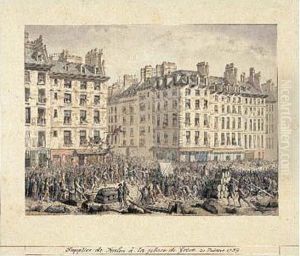Pierre Gabriel Berthault Paintings
Pierre Gabriel Berthault was a French engraver, born in Paris in 1737. He was an important figure in the art of engraving during the 18th and early 19th centuries. Berthault's career spanned a dynamic period in French history, encompassing the reign of Louis XV, the French Revolution, and the Napoleonic era. His works are characterized by a high level of detail and a strong commitment to accurately representing the subjects he engraved.
Berthault trained under the celebrated engraver Jean-Georges Wille, who was a key figure in promoting the art of engraving in France. Through this mentorship, Berthault developed his skills and began to establish his reputation. He worked on a variety of subjects, including portraits, landscapes, and historical scenes. One of his notable contributions was the illustration of books, where his engravings served to complement and enhance the written content.
During the turbulent years of the French Revolution and the rise of Napoleon, Berthault's work captured the changing political and social landscapes of France. He produced a series of engravings depicting events of the Revolution, which were significant in shaping the public's perception of these occurrences. As the official engraver for Napoleon, Berthault's works from this period provide a visual documentation of the Emperor's reign and campaigns.
Berthault was also known for his involvement in the 'Description de l'Égypte', a monumental publication that documented the findings of the Napoleonic expedition to Egypt from 1798 to 1801. This work was an important contribution to Egyptology and the study of ancient Egyptian civilization. Berthault's engravings in this collection are considered some of his finest work, showcasing his meticulous attention to detail and his ability to convey complex architectural and topographical information.
Pierre Gabriel Berthault's legacy as an engraver is preserved through his extensive body of work, which remains a valuable resource for historians and art enthusiasts. His engravings not only depict the aesthetic tastes and styles of his time but also serve as historical documents that provide insight into the events and culture of late 18th and early 19th century France. Berthault passed away in 1831, leaving behind a rich portfolio that continues to be studied and appreciated for its artistic and historical significance.
